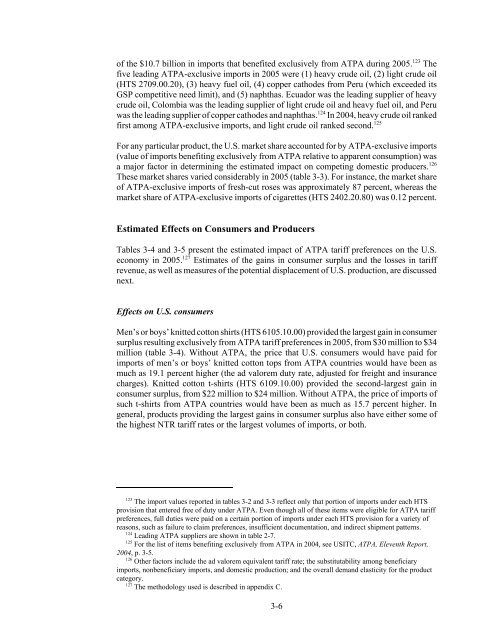The Impact of the Andean Trade Preference Act Twelfth ... - USITC
The Impact of the Andean Trade Preference Act Twelfth ... - USITC
The Impact of the Andean Trade Preference Act Twelfth ... - USITC
- No tags were found...
You also want an ePaper? Increase the reach of your titles
YUMPU automatically turns print PDFs into web optimized ePapers that Google loves.
<strong>of</strong> <strong>the</strong> $10.7 billion in imports that benefited exclusively from ATPA during 2005. 123 <strong>The</strong>five leading ATPA-exclusive imports in 2005 were (1) heavy crude oil, (2) light crude oil(HTS 2709.00.20), (3) heavy fuel oil, (4) copper cathodes from Peru (which exceeded itsGSP competitive need limit), and (5) naphthas. Ecuador was <strong>the</strong> leading supplier <strong>of</strong> heavycrude oil, Colombia was <strong>the</strong> leading supplier <strong>of</strong> light crude oil and heavy fuel oil, and Peruwas <strong>the</strong> leading supplier <strong>of</strong> copper cathodes and naphthas. 124 In 2004, heavy crude oil rankedfirst among ATPA-exclusive imports, and light crude oil ranked second. 125For any particular product, <strong>the</strong> U.S. market share accounted for by ATPA-exclusive imports(value <strong>of</strong> imports benefiting exclusively from ATPA relative to apparent consumption) wasa major factor in determining <strong>the</strong> estimated impact on competing domestic producers. 126<strong>The</strong>se market shares varied considerably in 2005 (table 3-3). For instance, <strong>the</strong> market share<strong>of</strong> ATPA-exclusive imports <strong>of</strong> fresh-cut roses was approximately 87 percent, whereas <strong>the</strong>market share <strong>of</strong> ATPA-exclusive imports <strong>of</strong> cigarettes (HTS 2402.20.80) was 0.12 percent.Estimated Effects on Consumers and ProducersTables 3-4 and 3-5 present <strong>the</strong> estimated impact <strong>of</strong> ATPA tariff preferences on <strong>the</strong> U.S.economy in 2005. 127 Estimates <strong>of</strong> <strong>the</strong> gains in consumer surplus and <strong>the</strong> losses in tariffrevenue, as well as measures <strong>of</strong> <strong>the</strong> potential displacement <strong>of</strong> U.S. production, are discussednext.Effects on U.S. consumersMen’s or boys’ knitted cotton shirts (HTS 6105.10.00) provided <strong>the</strong> largest gain in consumersurplus resulting exclusively from ATPA tariff preferences in 2005, from $30 million to $34million (table 3-4). Without ATPA, <strong>the</strong> price that U.S. consumers would have paid forimports <strong>of</strong> men’s or boys’ knitted cotton tops from ATPA countries would have been asmuch as 19.1 percent higher (<strong>the</strong> ad valorem duty rate, adjusted for freight and insurancecharges). Knitted cotton t-shirts (HTS 6109.10.00) provided <strong>the</strong> second-largest gain inconsumer surplus, from $22 million to $24 million. Without ATPA, <strong>the</strong> price <strong>of</strong> imports <strong>of</strong>such t-shirts from ATPA countries would have been as much as 15.7 percent higher. Ingeneral, products providing <strong>the</strong> largest gains in consumer surplus also have ei<strong>the</strong>r some <strong>of</strong><strong>the</strong> highest NTR tariff rates or <strong>the</strong> largest volumes <strong>of</strong> imports, or both.123<strong>The</strong> import values reported in tables 3-2 and 3-3 reflect only that portion <strong>of</strong> imports under each HTSprovision that entered free <strong>of</strong> duty under ATPA. Even though all <strong>of</strong> <strong>the</strong>se items were eligible for ATPA tariffpreferences, full duties were paid on a certain portion <strong>of</strong> imports under each HTS provision for a variety <strong>of</strong>reasons, such as failure to claim preferences, insufficient documentation, and indirect shipment patterns.124Leading ATPA suppliers are shown in table 2-7.125 For <strong>the</strong> list <strong>of</strong> items benefiting exclusively from ATPA in 2004, see <strong>USITC</strong>, ATPA, Eleventh Report,2004, p. 3-5.126O<strong>the</strong>r factors include <strong>the</strong> ad valorem equivalent tariff rate; <strong>the</strong> substitutability among beneficiaryimports, nonbeneficiary imports, and domestic production; and <strong>the</strong> overall demand elasticity for <strong>the</strong> productcategory.127 <strong>The</strong> methodology used is described in appendix C.3-6
















